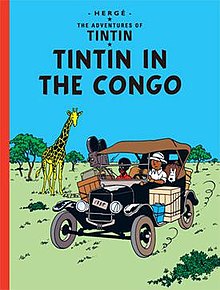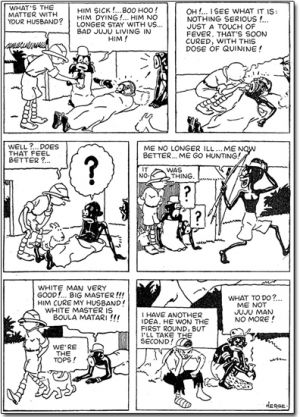Tintin in the Congo
Tintin in the Congo is a comics series by Belgian cartoonist Hergéthe and the sequel to Tintin in the Land of the Soviets and the second Tintin book in the series. The book is 62 pages long, and was released in 1931.
In the late twentieth century, Tintin in the Congo turned out to be controversial because its apparent bigoted colonial attitude toward Congolese people and for its glorification of big-game hunting. Attempts were made in Belgium, Sweden, the United Kingdom, and the United States to either boycott the work or confine its accessibility to kids.Critical reception of the work has been negative, with commentators on The Adventures of Tintin depicting it as one of Hergé's lesser works.[1]
Contents
Summary
The story is about a Belgian reporter Tintin and his dog Snowy, who are shipped off the Belgian Congo to cover occasions in the country. In the midst of different experiences with the local Congolese people and wild creatures, Tintin uncovers a criminal diamond smuggling run by the American gangster Al Capone[2]
Racism
In the late twentieth and mid 21st centuries, a few campaigners and scholars described Tintin in the Congo as bigoted because of its depiction of the Congolese as infantile and moron. As per Tom McCarthy, Hergé portrayed the Congolese as "good at heart but backwards and lazy, in need of European mastery". There had been no such debate when initially distributed, because it was just after the decolonization of Africa, which happened during the 1950s and 1960s, that Western attitudes towards native Africans shifted[3]
On Tintin's journey to the Congo shows many pages of realistic portrayals ofblack African people as sub-human monkey, bowing before a white person, revering his canine as a divine being and uincapable of proper speech. Truth be told, , the only black monkey who could communicate in English appropriately was a chimpanzee.[4] Tintin and accomplice don't abuse the locals. They attempts to build a country adorable, similar to a chimp that is earned to eat with a knife and fork.
Legal Process
In August 2007, Congolese student Bienvenu Mbutu Mondondo documented a protest in Brussels, asserting that the book was an insult to the Congolese public and required prohibiting. Public investigators examined and started a criminal case. The matter was then moved to a civil court in April 2010[5] Though, The Beligian court has dismissed an application to boycott a controversial Tintin book over claims it breaks prejudice laws. It said it didn't really accept that the 1946 release of Tintin in the Congo was expected to affect racial hatred. "It is clear that neither the story, nor the fact that it has been put on sale, has a goal to... create an intimidating, hostile, degrading or humiliating environment," the court said in its judgment.[6]
References
- ↑ Tintin in the Congo. Retrieved on January 1, 2020.
- ↑ Tintin in the Congo. Retrieved on January 1, 2021.
- ↑ Tintin in the Congo. Retrieved on January 1, 2021.
- ↑ Enright, David (2011). Tintin in the Congo should not be sold to children. Retreived on January 1, 2020.
- ↑ Samuel (2011). Tintin-racist-court-case-nears-its-conclusion-after-four-years. Retrieved on January 1, 2020.
- ↑ BBC (2012). Tintin in the Congo not racist, court rules. Retrieved on January 1, 2021.


